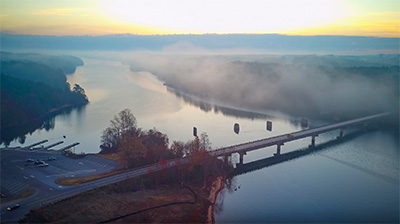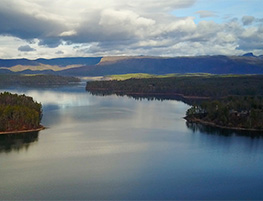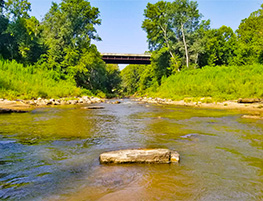Water
High-Quality Water for a Healthy EcosystemWater quality is a term that describes the condition of the water we use. The measure of water quality includes: chemical, biological and physical characteristics that can have both short term and long term effects on our communities. Having clean water and high water quality is important to our local economies and it serves an important measure for a safe environment and a thriving community in attracting new businesses, housing and recreation opportunities to our counties.
We all want safe water to drink, recreate and for use to irrigate our crops. High water quality affects the entire ecosystem both economically and environmentally. Carolina Land & Lakes remains committed to proper resource development water quality and sustainability.
You can find more info about Rocky Face Mountain Recreation Area Website.
Lake Rhodhiss nutrient study: During the 1999-2002 severe drought, Rhodhiss developed a serious taste and odor algae problem. Both Valdese and Lenoir were forced to install expensive activated carbon systems to combat the taste and odor in their potable water supply. A 319 funded project obtained by Carolina Land & Lakes addressed this cause and source of the nutrients causing the problem. The results and conclusions of this study now reside in the Department of Water Quality data files at Dept. of Environmental Quality (DEQ); copies are available upon request from the NC State office of DEQ or Carolina Land & Lakes.

Lake Hickory: Carolina Land & Lakes has a report on a five year nutrient study (N & P) in the water flowing thru Rhodhiss dam into Lake Hickory. The study was directed by Dr. Jon Knight, former Water Quality Specialist with Duke Energy. The City of Hickory collected bimonthly samples which were analyzed at the Duke Water Quality labs. Dr. Knight compared this data with Rhodhiss lake sampling for the past 30 years. This sampling is a good predictor of lake eutrophic conditions such as those experienced in Lake Rhodhiss in the early 2000's. DWQ is planning a non-point study for other Catawba basin streams and is referring to this study as a point of reference.
Stream Restoration
There's more to a stream than the rushing or meandering water. A stream corridor, or stream valley, is a complex and valuable ecosystem which includes the land, plants, animals, and network of streams within it. Recognition of the value of stream corridors has come with the understanding of what has been lost through uninformed or misguided actions on many streams and the watersheds that nourish them.
Carolina Land & Lakes serves as a pivotal player between government, industry and local stakeholders, gathering information, research and scientific data to address local conservation issues. We believe there are many valid points of view in dealing with sensitive conservation issues and we work to find mutually agreeable resolutions that prevent the wasteful use of valuable resources.
The U.S. has 3.5 million miles of rivers. The 1992 National Water Quality Inventory of 642,881 miles of these rivers stated that only 56 percent fully supported multiple uses, including drinking water supply, fish and wildlife habitat, recreation, and agriculture, as well as flood prevention and erosion control. In the remaining 44 percent of stream miles inventoried, sedimentation and excess nutrients were the most significant causes of degradation. Sediment problems result from soil erosion from watersheds and streambanks. Today, interest in restoring stream corridors is expanding nationally and internationally, as indicated by increasing numbers of case studies, published papers, technology exchanges, research projects, and symposia. Stream corridors are increasingly recognized as critical ecosystems supporting interdependent uses and values.
Dam Removal
Removing unwanted or no longer utilized dams brings back the life of a river or stream. It restores the water flow, creates natural flood plains and important ground filters and allows indigenous aquatic and plant life to move freely.
The benefits can be a reduction or elimination of a safety hazard, while restoring the natural movement of the river helping to restore down river water quality for a multitude of end users while improving the overall health of the watershed.
Removing dams requires input and cooperation from many jurisdictions including: sports and recreation concerns, conservation groups, agriculture/business enterprises and multiple governmental agencies.
Carolina Land & Lakes is uniquely qualified to bring together various concerns, interest groups and stake-holders for the greater benefit of the local community.
Our success with the Shuford Dam removal is an illustration of our capacity to bring a number of interested parties to the table to accomplish a shared goal.
Carolina Land & Lakes partnered with American Rivers and U.S. Fish and Wildlife Services to remove the Shuford Dam in Catawba County on the Henry Fork River. The dam was listed on the EPA's most hazardous list for public safety, making it a priority for the safety of our community. The project started in 2012 and was officially finished in November 2016. While working on the project Carolina Land & Lakes and partners were conscious of other infrastructure downstream of the dam and the impact of sediment. The Shuford dam removal was funded by a grant from the North Carolina Division of Water Resources and the US Fish and Wildlife Services Fish Passage Program.
To find more information about dam removal please visit American Rivers Website.




